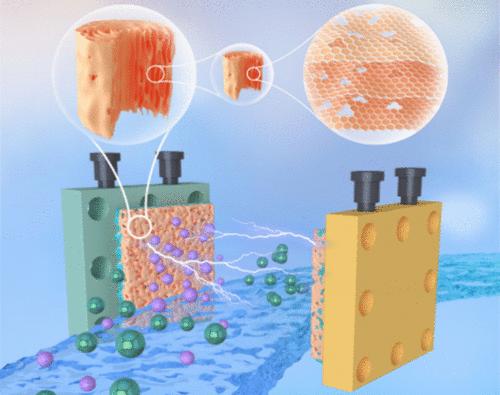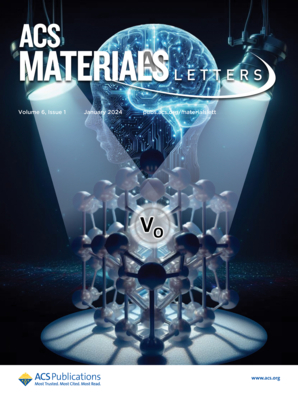Promoting Volumetric Desalination Rate and Capacity via Highly Oriented, Densified Graphene Architectures
IF 9.6
1区 化学
Q1 MATERIALS SCIENCE, MULTIDISCIPLINARY
引用次数: 0
Abstract
Advancing electrode materials with high adsorption capacity and fast rate is crucial for seawater desalination in capacitive deionization (CDI). Here, we propose a highly oriented, densified graphene (HODG) electrode characterized by its ordered/short ion transport channels, abundant oxygen functional groups, high packing density (1.374 g cm–3), and large specific surface area (543.72 m2 g–1), facilitating exceptional fast ion diffusion and ultrahigh volumetric desalination capacity. HODG delivers a volumetric capacitance of 308 F cm–3 at 1 A g–1, and a record-high volumetric salt adsorption capacity (v-SAC) of 57.70 mg cm–3 with a rapid rate of 1.92 mg cm–3 min–1 at 1.2 V in 1000 mg L–1 NaCl. Even after 50 cycles of adsorption–desorption, it can still retain 91.36% of its initial desalination capacity. This proposed design strategy offers a new avenue for the rational optimization of graphene architectures, boosting the development of high-performance CDI electrode materials toward practical applications.

通过高取向、致密化石墨烯结构提高海水淡化率和容量
开发具有高吸附容量和快速速率的电极材料对于电容式去离子(CDI)海水淡化至关重要。在这里,我们提出了一种高取向致密化石墨烯(HODG)电极,其特点是具有有序/短离子传输通道、丰富的氧官能团、高堆积密度(1.374 g cm-3)和大比表面积(543.72 m2 g-1),从而促进了特殊的快速离子扩散和超高体积脱盐能力。HODG 在 1 A g-1 时的体积电容为 308 F cm-3,在 1000 mg L-1 NaCl 溶液中的体积盐吸附容量(v-SAC)为 57.70 mg cm-3,在 1.2 V 电压下的吸附速度为 1.92 mg cm-3 min-1,创历史新高。即使经过 50 次吸附-解吸循环,它仍能保持 91.36% 的初始脱盐能力。这种设计策略为合理优化石墨烯结构提供了一条新途径,推动了高性能 CDI 电极材料向实际应用的发展。
本文章由计算机程序翻译,如有差异,请以英文原文为准。
求助全文
约1分钟内获得全文
求助全文
来源期刊

ACS Materials Letters
MATERIALS SCIENCE, MULTIDISCIPLINARY-
CiteScore
14.60
自引率
3.50%
发文量
261
期刊介绍:
ACS Materials Letters is a journal that publishes high-quality and urgent papers at the forefront of fundamental and applied research in the field of materials science. It aims to bridge the gap between materials and other disciplines such as chemistry, engineering, and biology. The journal encourages multidisciplinary and innovative research that addresses global challenges. Papers submitted to ACS Materials Letters should clearly demonstrate the need for rapid disclosure of key results. The journal is interested in various areas including the design, synthesis, characterization, and evaluation of emerging materials, understanding the relationships between structure, property, and performance, as well as developing materials for applications in energy, environment, biomedical, electronics, and catalysis. The journal has a 2-year impact factor of 11.4 and is dedicated to publishing transformative materials research with fast processing times. The editors and staff of ACS Materials Letters actively participate in major scientific conferences and engage closely with readers and authors. The journal also maintains an active presence on social media to provide authors with greater visibility.
 求助内容:
求助内容: 应助结果提醒方式:
应助结果提醒方式:


